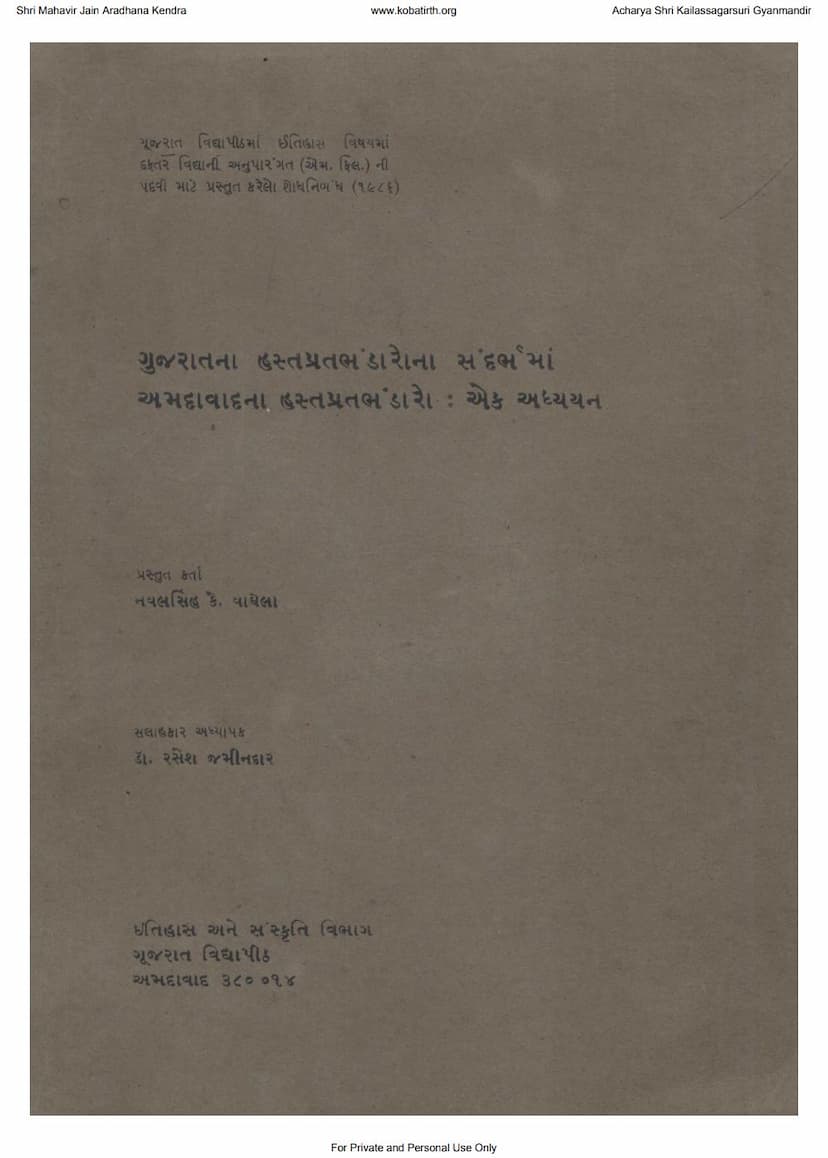Gujaratna Hastprat Bhandarona Sandharbhma Amdavadna Hastprat Bhandaro Ek Adhyayan
Added to library: September 1, 2025

Summary
This document is a scholarly study titled "A Study of the Manuscript Libraries of Gujarat with Special Reference to the Manuscript Libraries of Ahmedabad" (ગુજરાતના હસ્તપ્રતભંડારાના સંદર્ભમાં અમદાવાદના હસ્તપ્રતભંડારા: એક અધ્યયન). Authored by Navalsinh K. Vaghela and advised by Prof. Dr. Rasesh Jamindar, it was presented as a dissertation for an M. Phil. degree in Archival Science (equivalent to "Daftar Vidya" in Gujarati) from Gujarat Vidyapith in 1986.
The dissertation is a comprehensive exploration of manuscript collections, with a particular focus on those found in Ahmedabad, within the broader context of Gujarat.
Here's a breakdown of its key contents based on the provided pages:
Introduction and Background:
- The study acknowledges the vast repository of knowledge preserved in manuscripts across India and other countries.
- It highlights the historical context of manuscript creation, noting that before the advent of printing, all texts were handwritten, often on palm leaves or handmade paper.
- The foresight of ancestors in preserving this knowledge for future generations is recognized, leading to the establishment of numerous manuscript libraries in Gujarat, especially in Ahmedabad.
- The author's personal curiosity, sparked by encountering manuscripts with diverse scripts and styles in the Gujarat Vidyapith's repository, fueled this research. The author also mentions receiving primary training in manuscript science and conservation.
Methodology and Scope:
- The research involved visiting manuscript libraries in Ahmedabad, interacting with their staff and scholars, and collecting information.
- Printed materials were also consulted for reference.
- The study is structured into seven chapters, covering:
- Introduction
- Manuscripts: Their Creation and Types
- The Antiquity of Writing and Manuscripts in Gujarat
- Manuscript Libraries in Gujarat and Their Importance
- Manuscript Libraries in Ahmedabad (detailed analysis)
- Modern Methods for Preservation and Maintenance of Manuscripts
- Conclusion
- An appendix section includes information on the total number of manuscripts in Ahmedabad's libraries, a map showing the locations of Gujarat's manuscript libraries, and other relevant data.
Key Themes and Chapters:
- Chapter on Manuscripts (Creation and Types): This chapter defines manuscripts, discusses their importance, and explores their relationship with other disciplines like paleography (study of ancient writing) and linguistics. It details the materials used (palm leaves, cloth, birch bark, paper), the writing instruments, ink preparation, and various types of manuscripts based on format, writing style, and inks.
- Writing History in India and Gujarat: The study outlines the history of writing in India and Gujarat, emphasizing the role of manuscripts in preserving this art.
- Manuscript Libraries in Gujarat: This section discusses the significance of manuscript libraries across Gujarat, their locations, the quantity of manuscripts they hold, and available information.
- Manuscript Libraries in Ahmedabad: This is a core focus, providing details on Ahmedabad's manuscript libraries, including their establishment, history, administration, the number and types of manuscripts, significant holdings, arrangement and preservation methods, and modern maintenance techniques.
- Preservation and Maintenance: The study covers both ancient and modern techniques used for preserving and maintaining manuscripts, including methods for repairing damaged documents.
- Comparative Study: The work also aims to present a comparative analysis of Ahmedabad's manuscript libraries with those in other parts of Gujarat, highlighting their unique characteristics.
Detailed Exploration of Manuscript Aspects:
The document goes into significant detail on various aspects of manuscripts:
- Materials: Discusses the use of birch bark (bhojpatra), agaroo bark, cloth, palm leaves (tadpatra), and paper, detailing their preparation methods.
- Writing Instruments: Explains the use of styluses, pens (kalams), quills, and brushes.
- Inks: Details the preparation of black, red, gold, and silver inks used in ancient times.
- Tools for Writing and Binding: Describes tools like rulers (rekhani), inkwells (khadi), binding cords, and decorative elements.
- Types of Manuscripts: Categorizes manuscripts based on size, writing style (e.g., dvipadi, tripadi, panchpath), layout, and artistic elements like illustrations.
- Historical Context: Places the development of writing and manuscripts within the broader historical and cultural context of India and Gujarat, including the influence of various religions and dynasties.
- Preservation Challenges and Methods: Addresses the factors causing damage to manuscripts (humidity, heat, light, insects, chemicals) and discusses ancient and modern conservation techniques.
Focus on Ahmedabad's Manuscript Libraries:
The dissertation dedicates substantial effort to cataloging and describing the manuscript collections within Ahmedabad. It lists numerous libraries, specifying their locations, the approximate number of manuscripts, and sometimes details about their holdings, management, and historical background. This includes Jain libraries (managed by monks/trustees), libraries associated with research institutions or universities, and even those belonging to Muslim organizations.
Key Scholars and Contributions:
The study frequently mentions the significant contributions of figures like Muni Shri Punyavijayji Maharaj, whose efforts in collecting, organizing, and preserving manuscripts in Gujarat and Rajasthan are highly praised. Other scholars and institutions are also acknowledged for their roles in manuscript preservation and research.
Overall Objective:
The dissertation aims to provide a detailed study of manuscript libraries in Gujarat, with a specific emphasis on Ahmedabad, contributing to the understanding and preservation of India's rich literary and cultural heritage. It serves as a valuable resource for researchers and anyone interested in the history of manuscripts and libraries in the region.